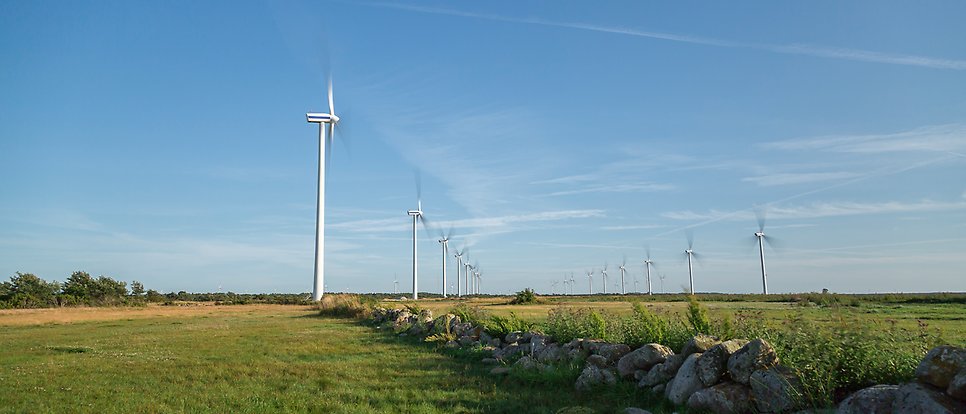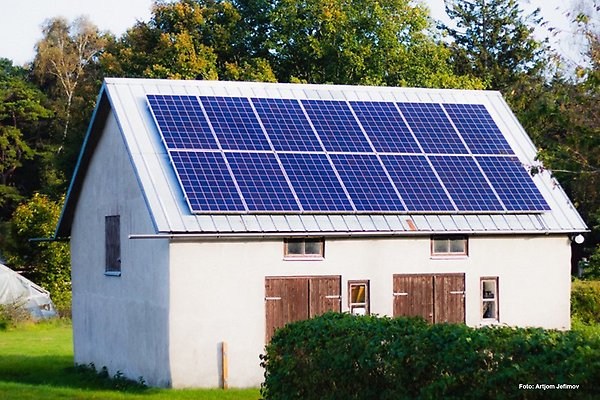Wind Energy

We combine leading research on wind energy modeling with interdisciplinary research on sustainable energy transition. We investigate topics such as how to maximize the electricity production from wind farms and how a transition to a sustainable energy system can be achieved.
Description
A large-scale expansion of wind energy is an important part of a sustainable energy transition. At the same time, an increased understanding of the transition processes related to such a development is necessary. We work both to increase the understanding of how to maximize the contribution from wind energy, but also broader with investigating what is required for a sustainable energy transition in all parts of the energy system.
Our research combines an international, national and regional focus and takes place in close collaboration with the industry and other actors in society. We lead the research center Swedish Wind Center (SWC), which collects and develops research-based knowledge about wind power.
The research is closely linked to our teaching and we organize a master's program in wind power project development and a bachelor's program in sustainable energy transition, as well as several freestanding courses in both subjects. Research in Wind Energy is conducted on Campus Gotland.
Our Research
Wind modeling
Our research in wind modeling focuses on the understanding of how the atmosphere interact with wind turbines and wind farms of increasing size, both on and off-shore. We consider how the flow within and around wind farms are affected of atmospheric conditions. Being located in the middle of the Baltic Sea, its specific conditions are of particular interest. Swedish conditions on land with varying conditions and lots of forest are also in our focus area. We use advanced numerical modeling that takes into account how wind conditions vary over time to how turbines placed in parks can make use of the energy and how these affect the flow. Here we study e.g. turbulence levels inside parks and how this affects the life time of turbines. Today, there are a large number of farms planned in e.g. the North and Baltic Sea that will impact each other. Therefore, the wind modeling activities also have a strong link to the energy transition field considering the planning aspects of the wind energy and how a large share of wind energy in a system can be handled.

Energy transition
Our interdisciplinary research investigates sustainable energy transition from different perspectives and at varying scales, from the local to the global. We use methods from a number of academic disciplines to, among other things, study inclusive transition processes, decision support, and transition mechanisms. Being located on an island, the unique conditions on islands and for the rural communities are of a specific interest, but also the connection to global developments. Coming from a wind power focused research environment, there is an extra interest in the role of wind power can have in future sustainable energy systems.

PhD Studies
According to international evaluations, Uppsala University has some of the most comprehensive research in geosciences in Europe, and our doctoral students at Uppsala University are among the most satisfied with their doctoral education. We offer doctoral studies in eight research areas.
Read more about our PhD Studies.
Publications
A fast-running physics-based wake model for a semi-infinite wind farm
Part of Journal of Fluid Mechanics, 2024
- DOI for A fast-running physics-based wake model for a semi-infinite wind farm
- Download full text (pdf) of A fast-running physics-based wake model for a semi-infinite wind farm
Energy planning for islands: Guiding island energy transition and decision-making
2024
Part of Energy Reports, p. 1399-1411, 2024
- DOI for Impact of turbine availability and wake effect on the application of dynamic thermal rating of wind farm export transformers
- Download full text (pdf) of Impact of turbine availability and wake effect on the application of dynamic thermal rating of wind farm export transformers
Part of Wind Energy Science, p. 821-840, 2024
- DOI for Machine learning methods to improve spatial predictions of coastal wind speed profiles and low-level jets using single-level ERA5 data
- Download full text (pdf) of Machine learning methods to improve spatial predictions of coastal wind speed profiles and low-level jets using single-level ERA5 data
Spatial multicriteria framework for sustainable wind-farm planning - Accounting for conflicts
Part of Renewable & sustainable energy reviews, 2024
- DOI for Spatial multicriteria framework for sustainable wind-farm planning - Accounting for conflicts
- Download full text (pdf) of Spatial multicriteria framework for sustainable wind-farm planning - Accounting for conflicts
Unravelling the ‘collective’ in sociotechnical imaginaries: A literature review
Part of Energy Research & Social Science, p. 103422-103422, 2024
Actuator line model using simplified force calculation methods
Part of Wind Energy Science, p. 363-382, 2023
- DOI for Actuator line model using simplified force calculation methods
- Download full text (pdf) of Actuator line model using simplified force calculation methods
Brief communication: On the definition of the low-level jet
Part of Wind Energy Science, p. 1651-1658, 2023
- DOI for Brief communication: On the definition of the low-level jet
- Download full text (pdf) of Brief communication: On the definition of the low-level jet
Comparison of three DWM-based wake models at above-rated wind speeds
Part of WAKE CONFERENCE 2023, 2023
- DOI for Comparison of three DWM-based wake models at above-rated wind speeds
- Download full text (pdf) of Comparison of three DWM-based wake models at above-rated wind speeds
Energy transition awareness: Can it guide local transition planning on islands?
Part of Heliyon, 2023
- DOI for Energy transition awareness: Can it guide local transition planning on islands?
- Download full text (pdf) of Energy transition awareness: Can it guide local transition planning on islands?
How Fast is Fast Enough?: Industry Perspectives on the Use of Large-eddy Simulation in Wind Energy
Part of WAKE CONFERENCE 2023, 2023
- DOI for How Fast is Fast Enough?: Industry Perspectives on the Use of Large-eddy Simulation in Wind Energy
- Download full text (pdf) of How Fast is Fast Enough?: Industry Perspectives on the Use of Large-eddy Simulation in Wind Energy
Modelling of wind turbine wakes over forests along the diurnal cycle
Part of WAKE CONFERENCE 2023, 2023
- DOI for Modelling of wind turbine wakes over forests along the diurnal cycle
- Download full text (pdf) of Modelling of wind turbine wakes over forests along the diurnal cycle
Modelling the flow response to surface heterogeneity during a semi-idealized diurnal cycle
Part of Journal of Applied Meteorology and Climatology, p. 511-527, 2023
On the accuracy of predicting wind-farm blockage
Part of Renewable energy, p. 114-129, 2023
- DOI for On the accuracy of predicting wind-farm blockage
- Download full text (pdf) of On the accuracy of predicting wind-farm blockage
Peculiar Winds At The Coast: And How To Catch Them!
Part of Frontiers for Young Minds, 2023
- DOI for Peculiar Winds At The Coast: And How To Catch Them!
- Download full text (pdf) of Peculiar Winds At The Coast: And How To Catch Them!
The characteristics of helically deflected wind turbine wakes
Part of Journal of Fluid Mechanics, 2023
- DOI for The characteristics of helically deflected wind turbine wakes
- Download full text (pdf) of The characteristics of helically deflected wind turbine wakes
The Lattice Boltzmann Method for Wind Farm Simulations: Validation and Application
2023
Validation of a Lattice Boltzmann Solver Against Wind Turbine Response and Wake Measurements
Part of WAKE CONFERENCE 2023, 2023
- DOI for Validation of a Lattice Boltzmann Solver Against Wind Turbine Response and Wake Measurements
- Download full text (pdf) of Validation of a Lattice Boltzmann Solver Against Wind Turbine Response and Wake Measurements
Part of Energy, 2022
- DOI for Analyzing the mechanisms behind temporal correlation between power sources using frequency separated time scales: A Swedish case study on PV and wind
- Download full text (pdf) of Analyzing the mechanisms behind temporal correlation between power sources using frequency separated time scales: A Swedish case study on PV and wind
Classification and properties of non-idealized coastal wind profiles - an observational study
Part of Wind Energy Science, p. 1183-1207, 2022
- DOI for Classification and properties of non-idealized coastal wind profiles - an observational study
- Download full text (pdf) of Classification and properties of non-idealized coastal wind profiles - an observational study
Decarbonisation of islands: A multi-criteria decision analysis platform and application
Part of Sustainable Energy Technologies and Assessments, 2022
- DOI for Decarbonisation of islands: A multi-criteria decision analysis platform and application
- Download full text (pdf) of Decarbonisation of islands: A multi-criteria decision analysis platform and application
Efficient Large-eddy Simulation for Wind Energy Applications
2022
Energy scenarios for the Faroe Islands: A MCDA methodology including local social perspectives
Part of Sustainable Futures, 2022
- DOI for Energy scenarios for the Faroe Islands: A MCDA methodology including local social perspectives
- Download full text (pdf) of Energy scenarios for the Faroe Islands: A MCDA methodology including local social perspectives
2022
Mapping coastal upwelling in the Baltic Sea from 2002 to 2020 using remote sensing data
Part of International Journal of Applied Earth Observation and Geoinformation, 2022
- DOI for Mapping coastal upwelling in the Baltic Sea from 2002 to 2020 using remote sensing data
- Download full text (pdf) of Mapping coastal upwelling in the Baltic Sea from 2002 to 2020 using remote sensing data

